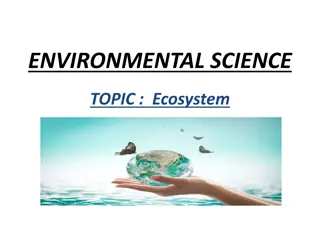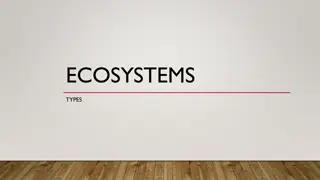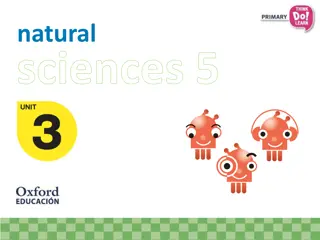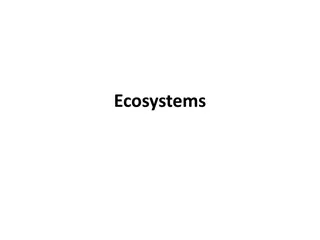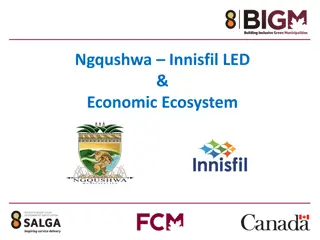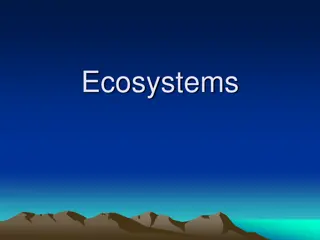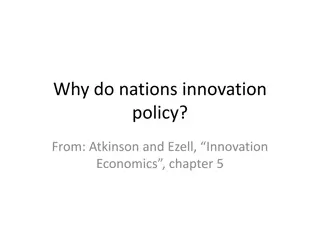Insights on Ecosystems of Innovation and Government Role
Delve into the dynamics of innovation ecosystems and the vital role of government in fostering innovation. Topics include bridging gaps, open innovation, the demand side of innovation ecosystems, Candy Innovation Model, and key conclusions drawn. Explore how technology and market value are added, steps in valuation, and the transition from business plans to models. Understand the significance of internal and open innovation management.
Download Presentation

Please find below an Image/Link to download the presentation.
The content on the website is provided AS IS for your information and personal use only. It may not be sold, licensed, or shared on other websites without obtaining consent from the author. Download presentation by click this link. If you encounter any issues during the download, it is possible that the publisher has removed the file from their server.
E N D
Presentation Transcript
ECOSYSTEMS OF INNOVATION AND THE ROLE OF THE GOVERNMENT Josep M. Pique jmpique@TechnovaBarcelona.org @JosepMPique
AGENDA 1. BRIDGING THE GAP 2. OPEN INNOVATION & OPEN GOVERNMENT 3. THE DEMAND SIDE OF ECOSYSTEMS OF INNOVATION 4. CANDY INNOVATON MODEL 5. CONCLUSIONS
1.1.- BRIDGING DE GAP People Bridging Value Opportunity Tech Money ECOSYSTEM INNOVATION Source: Jerry Engel, Josep Pique & Itxaso del Palacio, 2010.
1.2.- ADDING TECHNOLOGY VALUE Market Introduction Regulatory Approvals Manufacturing Prototype Value Working Prototype Patent Application Feasibility or Prototype Concept Time Source: Jerry Engel, Josep Pique & Itxaso del Palacio, 2010.
1.3.- ADDING MARKET VALUE Backlog Satisfied Customers Market Launch Beta Test Value Technical Reports Published Surveys/Concept Testing Qualitative Research (Focus Groups) Market Analysis - Published Data Time Source: Jerry Engel, Josep Pique & Itxaso del Palacio, 2010.
1.4.- VALUATION IN STEPS Predictable Scale Scale Validated Market Traction Early Validation I II III IV Concept Defined Time Source: Jerry Engel, Josep Pique & Itxaso del Palacio, 2010.
1.5.- FROM BUSINESS PLAN TO BUSINESS MODEL Source: Jerry Engel Steve Blank 2015
2.- OPEN INNOVATION & OPEN GOVERNMENT
2.1.- INTERNAL INNOVATION Source: Guide of Innovation - ACC10
2.3.- GLOBAL INNOVATION ECOSYSTEM Global National International International Regional Local Science Technology Industry Market Innovation Innovation Source: Francesc Sol Parellada, Josep Piqu & Joan Bellavista. 2007.
2.4.- OPEN INNOVATION TOOLKIT Location Internal External Aligns with Core Internal Development Acquisition Fit Non-core New Business Investment Source: Jerry Engel, 2011
2.4.- OPEN INNOVATION TOOLKIT Location Internal External Aligns with Core Internal Development Acquisition Fit Non-core New Business Investment Source: Jerry Engel, 2011
2.4.- OPEN INNOVATION TOOLKIT Location Internal External Business Unit Champions Aligns with Core Acquisition Fit Non-core New Business Investment Source: Jerry Engel, 2011
2.4.- OPEN INNOVATION TOOLKIT Location Internal External Business Unit Champions Aligns with Core Sourcing Tech Scouts Fit Non-core New Business Investment Source: Jerry Engel, 2011
2.4.- OPEN INNOVATION TOOLKIT Location Internal External Business Unit Champions Aligns with Core Sourcing Tech Scouts Fit Outside Experts Entrepreneurs Non-core Investment Source: Jerry Engel, 2011
2.4.- OPEN INNOVATION TOOLKIT Location Internal External Aligns with Core Business Unit Champions Sourcing Tech Scouts Fit Outside Experts Entrepreneurs Corporate VC Venture Capital Non-core Source: Jerry Engel, 2011
3.- THE DEMAND SIDE OF ECOSYSTEMS OF INNOVATION
3.1.- TRIPLE HELIX + DEMAND Government Government Quadruple Helix Quadruple Helix Demand Side Market Needs Challenges Tax & Law Organization Public Procurement University University Industry Industry Education Research Transfer Corporation SME New Source: Josep Pique, Montse Pareja & Luis Sanz, 2014.
3.3.- DEMAND: PUBLIC CHALLENGES ENVIRONMENT IT WATER NATURE ENERGY WASTE MOBILITY CITY DIMENSION PUBLIC SPACE P BLIC SERVICES OPEN GOVERNMENT INFORMATION
3.4.- ROLES IN THE PATH TO GROW University Industry Government Source: Henry Etzkowitz, Francesc Sol Parellada & Josep Piqu . 2007.
3.6.- PUBLIC LAB: LOCAL AND GLOBAL Local and Global From local to global (internationalization) SCIENCE AND SCIENCE AND TECNOLOGY TECNOLOGY CITY, MARKET CITY, MARKET COMPANIES, COMPANIES, INDUSTRY INDUSTRY and from global to local (foreing investment attraction) ...
CANDY INNOVATION MODEL CANDY INNOVATION MODEL F I L T E R F I L T E R F I L T E R A. CHALLENGES D. SCALING C. DEVELOPMENT B. IDEAS I I I I I I
4.1.- CHALLENGES user participation
4.2.- FILTERS OF CHALLENGES F I L T E R I
i-lab HARVARD The i-lab is a unique collaboration and education space designed to foster entrepreneurship and innovation across Harvard University. i-Labs is divided into Explore, Meet, Ideate, Prototype+Build and Launch+Growth. Explore is stimulating the community with daily events, including training, workshops and hackathons. https://i-lab.harvard.edu
4.3.- IDEAS Open Call Call for solutions Ex: Open Challenge Internal/External Workshop B. IDEAS Ecology of innovation Ecosystem EX: Lab user participation
4.4.- FILTER OF IDEAS F I L T E R I I
STANFORD d.school d.school is a place for explorers & experimenters at Stanford University 8 core abilities: - Navigate Ambiguity - Learn from others - Synthesize Information - Experiment Rapidly - Move Between Concrete and Abstract - Build and Craft Intentionally - Communicate Deliberately - Design your Design Work https://dschool.stanford.edu
4.5.- DEVELOPMENT Concept Validation Innovation Canvas C. DEVELOPMENT Prototyping user participation
4.6.- FILTER OF DEVELOPMENTS F I L T E R I I I
MIT MEDIA LAB & CBA MIT Media Lab researchers design technologies for people to create a better future. MIT s Center for Bits and Atoms (CBA) manages a research facility for making and measuring things on length scales from atoms to buildings Fab Labs provide widespread access to modern means for invention. They began as an outreach project from MIT's CBA. http://fab.cba.mit.edu/
4.7.- SCALING Local D. SCALING International
LIVING LABS Living Labs (LLs) are defined as user-centred, open innovation ecosystems based on systematic user co- creation approach, integrating research and innovation processes in real life communities and settings. That s the place where validate and show the result of innovation. http://openlivinglabs.eu/
CANDY INNOVATION MODEL Open Call F I L T E R Concept Validation Call for solutions Ex: Open Challenge F I L T E R F I L T E R Problem Local Internal/External Workshop A. CHALLENGES Innovation Canvas D. SCALING Aspiration B. IDEAS C. DEVELOPMENT I I I International I Opportunity Ecology of innovation I I Ecosystem EX: Lab Prototyping user participation
LA SALLE La Salle is developing a Transversal Project that takes advantage of the entire Knowledge Ecosystem of the Campus: Groups of Research, Teaching and Technova. Serving businesses, entrepreneurs, universities, public administration and society in general - Local and International 1. 2. 3. 4. 5. 6. 7. 8. Creativity Room Maker Space CitiLab Visits Transferring Room Meeting Rooms Facilities Congress Room This project has been financed in 50% by the European Regional Development Funds of the European Union in the framework of the ERDF Operational Programme for Catalonia 2014-2020
CONCLUSIONS BENEFITS FOR TARGETS 1. Citizens: More and better products and solutions for better municipal services. 2. Businesses: access. Learn, shorten time to market and competitiveness. Real-life testing space for easier increase their market 3. Science technology transfer, both locally and internationally. and Technology: It s a powerful tool for 4. Public administration: Facilitate the introduction of new solutions. Innovation as a brand related to Barcelona. Transparency and efficiency in public procurement.
CONCLUSIONS SOME TIPS 1. Multidisciplinary work teams: Involve the owner or owners from the very beginning (definition of challenge, member of the jury, management of the implementation) 2. Open Challenge: Be sure is balanced. Take into account: the effort you can put in this process ( , HR, ), the type of solution you are looking for and the timing. to any ideas vs. calls related to specific 3. Solutions vs Challenges: Don t ask for a solution, expose a challenge to be solve. 4. Legal aspects: Be sure that you take into account the legal framework for buying innovation in your country. From the first moment decide if you are looking for ideas, if you want to pilot or you are willing to buy a product/service.
CONCLUSIONS - PROCESS 1. The Discovery process based on Challenges 2. Filtering as soon as you can 3. Systematization of the Ideation 4. Prototyping 5. Business Model 6. Learning Local & Growing Global
THANK YOU ! Josep M. Pique jmpique@TechnovaBarcelona.org @JosepMPique









